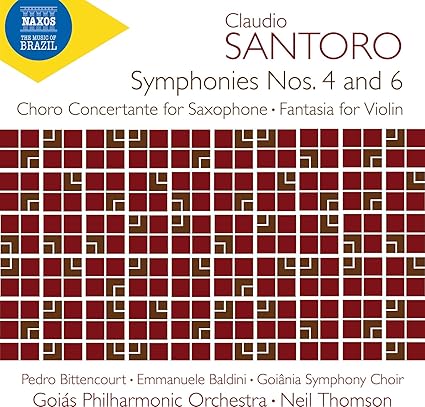

Canto de Amor e Paz (1950) Symphony No. 4 'Sinfonia da Paz' {Symphony of Peace} (1953-54) Choro Concertante for Tenor Saxophone and Orchestra (1951) Symphony No. 6 (1957-58) Fantasia for Violin and Orchestra (1959-60/1980)
You wouldn't be very far off the mark if, upon hearing the opening of the first movement of the Symphony No. 4 by Brazilian composer Claudio Santoro (1919-1989), you assigned the music to Aaron Copland. After all, they both studied in France under Nadia Boulanger (Copland in the 1920s and Santoro during the 1940s), but that is where the comparison ends. Santoro was a much more cosmopolitan sounding composer than Copland. As a matter of fact, except for some rhythmic patterns now and then that give him away, he doesn't even sound Brazilian when compared to say Villa-Lobos for example.
By the time the Symphony No. 4 'Sinfonia da Paz' was written, Claudio Santoro had served his time following the serial technique trend of the day, but after realizing its limitations, he opted to focus on slightly more traditional and formal musical miens. Although as pointed out in a previous review of his Symphonies 5 & 7, "his integration of folk elements within his music is much more subtle in its implementation." With its bold and emphatic opening, the first movement sounds like a call for all people to unite and work together to achieve enduring peace. With its combination of brash and lyrical passages it paves the way and sets the tone for the whole work. Its slow and mournful second movement, which progressively rises to a wrenching climax is put across extremely well here by the members of the Goiás Philharmonic Orchestra under the expressive direction of British conductor Neil Thomson. The Goiânia Symphony Choir joins in to proclaim the final movement's 'Song of the People' which Santoro himself describes as follows: "I wrote the finale as if it were a joyful carnival parade, with people waving flags and banners ... that was the idea, which is why it uses typical Brazilian percussion, redolent of Rio de Janeiro, where I imagined people on the [Avenida] Rio Branco calling for peace."
With its agitated rhythmic and arrhythmic patterns, the opening Allegro giocoso of the Symphony No. 6 demonstrates that Claudio Santoro was not a "thematic" composer, instead pushing the music forward in organic bursts of development. This symphony, which was premiered in 1963, was the work of a composer working against the grain, still struggling to find his voice. He wrote a total of fourteen symphonies, all of which speak of a composer proficient and skilled at his trade, if not highly memorable. His is solid, good music, but unfortunately his cosmopolitan style lacks a distinctive personality.
The Naxos label, along with the Brazilian Ministry of Foreign Affairs, are to be commended on their continuing efforts to bring highly neglected Brazilian music to the world stage.
Jean-Yves Duperron - September 2024 Symphony No. 6 - Opening Movement